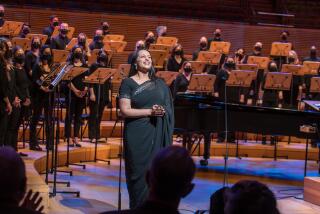MUSIC : Composer Puts Words at Fore of Memorial
- Share via
One thing was sure when James Hopkins began writing his new “Songs of Eternity”: He wanted the words to be crystal-clear.
“The text is not simply a skeleton you use to hang music on,” Hopkins says. “The only reason for setting a text is that it must be clear. You have to enhance it or bring something else to it, otherwise there is no reason to do it.”
The new work will premiere Sunday in a performance by the Pacific Chorale at the Orange County Performing Arts Center in Costa Mesa. It was commissioned by the Orange County Philharmonic Society through a donation from Dr. Edward and Helen Shanbrom of Santa Ana, to mark the chorale’s 25th anniversary and to commemorate David Lee Shanbrom, their son, who was killed in a traffic accident in 1986. He was 26.
The program will be conducted by John Alexander and also will include the West Coast premiere of Dominick Argento’s Te Deum, and Leonard Bernstein’s “Chichester Psalms.”
The text of “Songs of Eternity” consists of three poems by Bengali poet and dramatist Rabindranath Tagore, who won the Nobel Prize for Literature in 1913. The poems, picked by the Shanbroms, are drawn from Tagore’s plays and not from “Gitanjali,” the collection of mystical poems perhaps best-known to Western readers through the promotion of William Butler Yeats.
“In the case of the third poem, ‘Peace, my heart,’ ” says Hopkins, “my biggest concern was just staying out of the way of the text. It was just so strong and beautiful.
“The piece is the most tonal thing I’ve written for years. But this is absolutely appropriate for that text. I didn’t want any distractions from what was happening in that poem.”
Hopkins, 54, is a professor of music theory and composition at USC where he has been teaching for 22 years. He was born in Pasadena, studied music at USC, Yale and Princeton, and also has taught at Northwestern University in Illinois. He has written seven symphonies, several other large-scale works and “lots of choral music” for a church in Pasadena where he is an organist.
In this piece, he treats the orchestra and the chorus as “equal partners. The orchestra is in no way an accompaniment.” In most choral music, the orchestra plays the same musical lines that the singers’ sing but in this the chorus is “absolutely independent,” Hopkins says.
“That was a very deliberate decision. Orchestration is my specialty, and my experience has shown that when you start doubling vocal lines, you get in the way of the intelligibility of the words.”
Before writing a note of the piece, Hopkins “spent an awful lot of time studying the texts and taking them apart in the way I wanted to treat them.
“I found recurring words and ideas. I spent a lot of time trying to become familiar with them and created motifs that go along with them--specific words such as ‘song’ or ‘singing’ or anything having to do with that, which recur in each of the three movements.”
Given those recurrences, the work, not surprisingly, is cyclical. “There is an instrumental introduction that is somewhat incomplete which opens the whole piece,” Hopkins says, “and that recurs, but in a complete form, at the end of the last movement.”
More to Read
The biggest entertainment stories
Get our big stories about Hollywood, film, television, music, arts, culture and more right in your inbox as soon as they publish.
You may occasionally receive promotional content from the Los Angeles Times.










